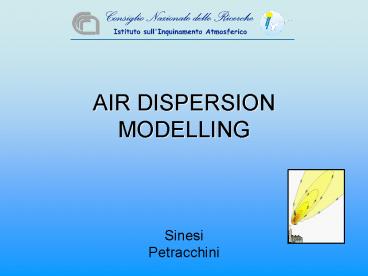AIR DISPERSION MODELLING - PowerPoint PPT Presentation
1 / 13
Title:
AIR DISPERSION MODELLING
Description:
Generalized process for performing a refined air dispersion modelling assessment ... In the model two point sources are inserted (Stack01 and STACK02), three ... – PowerPoint PPT presentation
Number of Views:417
Avg rating:3.0/5.0
Title: AIR DISPERSION MODELLING
1
AIR DISPERSION MODELLING
- Sinesi
- Petracchini
2
Generalized process for performing a refined air
dispersion modelling assessment
- 1-Emission Estimates
- Type of Chemicals
- Emission rate
- Phase-Vapoir/Solid
- 2-Site Parameters
- Land Use
- Buildings
- Source Location
- Terrain
- 3-Met Data
- Wind Speed
- Wind Direction
- Temperature
- Mixing Height
Buildings Downwash
Terrain Processing
- Source Inputs
- Coordinates
- Rlease Height
- Exit Temp
- Exit Velocity
- Emission Rate
- Met Processing
- Stability Parameter
- Micrometeorology Parameter
AIR DISPERSION MODEL
3
The AERMOD air dispersion modeling system
AERMAP
DEM file
NWS Surface
(1)
Surface file
AERMET
AERMOD
Upper Air
(1)
Profile File
On-Site
(1) From raw data files, AERMAP and AERMET
generate, the new file input to the model.
4
AERMET
AERMET
Row Data
5
AERMAP
- DEM file for complex terrain
- Import JPG or TIF as referenced background
- Construction of the 3D model of the city.
- Development and design of the emission sources
6
MAP MANAGER TOOL
SHANGHAI AIR POLLUTANT
EMISSION MONITORING APEM PROJECT TRAINING COURSE-
ITALY 21-20-01-2007
7
3D MODEL
- DEM esempi
- Sito 01 come è stato costruito immagini
8
CLASS SIMULATON (1)
Emission INPUT
In the model two point sources are inserted
(Stack01 and STACK02), three buildings (BLD,
BLD2, BLD3) and two nested greed as receptors
(GRD1 and GRD2)
9
CLASS SIMULATION (2)
It is run with one hour average, and 24 hours
average for one year
10
CLASS SIMULATION (3)
All sources included- Results of First Highest
concentrations
1h average
Contours 50 to 2000
One year simulation
11
CLASS SIMULATION (4)
All sources- First Highest concentration
1h average
Contours 50 to 2000
NB Change the meteorological period - only
January
12
CLASS SIMULATION
All sources - First Highest concentration
24h average
Contour 50 to 450
One year simulation
13
CLASS SIMULATION
All sources- First Highest Concentration
24h average
Contours 50 to 450
NB Change the meteorological period- only January

